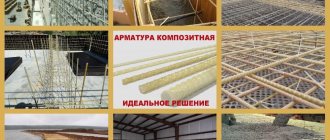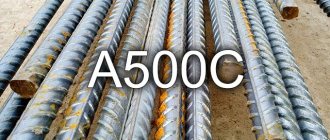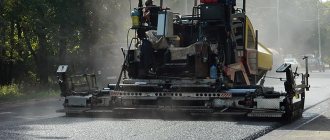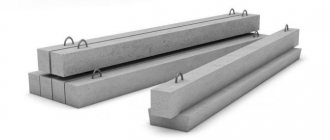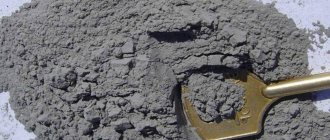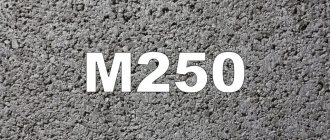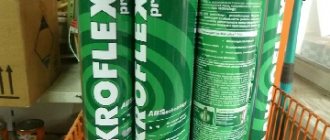Metal reinforcement is considered a reliable option for forming the “skeleton” of monolithic concrete. And today its importance and necessity in construction is not in doubt, although a new type of reinforcement has appeared on the market and is steadily progressing - composite or fiberglass (FRP). The material can be called “new” quite conditionally; it came to the market 50 years ago. For Russia, fiberglass was irrelevant until recently; we have enough resources to produce our own metal at a reasonable price for construction.
At the same time, fiberglass reinforcement has caught up and surpassed metal in a number of properties, and conclusions about the strength and durability of the material can be drawn from global experience in operating spas.
Structure of composite reinforcement
A building material is made from fiberglass fiber impregnated with a polymer binder in the form of relief rods of a given size - fiberglass reinforcement. Material structure:
- Inner rod. Serves to provide basic functional characteristics. Fiberglass fibers are used in production. They are placed in the structure of the rods in parallel or in the form of braided weaving, then filled with polymer resin.
- External covering. It is performed by winding composite fibers onto an internal rod or by spraying a fine abrasive onto it.
Fiberglass reinforcement technology
Main stages:
- The formwork is being prepared;
- A level mark is set to which the concrete mixture is poured. Using a water level, it is applied to the inside of the formwork;
- Bricks are laid at the bottom of the foundation, which is necessary to position the reinforcing mesh at a distance of approximately 50 mm from the edges of the formwork;
- 2 rows of fiberglass reinforcement are laid on the bricks using solid rods;
- Horizontal lintels are laid;
- The rods are fastened with nylon clamps (plastic ties);
- Vertical rods, upper longitudinal and transverse, equal to the lower parts of the reinforcing mesh, are installed and fixed.
- The foundation is poured with concrete.
It is important to note that larger projects or slabs may require steel reinforcement under the floor screed to provide additional strength. In addition, when working on a large project, it is important to carefully study the plans, requirements for buildings and make a competent calculation of the floor reinforcement. Some locations require reinforcement regardless of the size and scale of the concrete.
“Setka Plus” is a fiberglass reinforcement plant where you can place an order for a batch of any volume.
Standard sizes and parameters
The diameter of the produced spa varies in the range of 4 – 18 mm. Products are produced in the form of measuring rods or in coils.
The total length of the reinforcement in the coil depends on the technological equipment used in its manufacture. Spas with a diameter of 12 mm or more are offered to the consumer exclusively in the form of rods.
The main parameters affecting the scope of application include the weight of one meter and the diameter of the composite rod.
The winding pitch can be considered an additional characteristic, but today almost all manufacturers produce reinforcement with a pitch of 15 mm.
Advantages of plastic fittings
When comparing composite rods with metal rods (we have already carried out a comparison in this article), a number of pros and cons of plastic reinforcement are clearly identified. These include:
- reducing the weight of the reinforcement frame by 5-7 times;
- higher strength, allowing the diameter of the rods to be reduced;
- resistance to corrosion and chemicals in concrete;
- simple installation and high speed of assembly of reinforcing frames;
- simplified technology for creating round and oval structures;
- excellent dielectric and thermal insulation properties;
- ease of transportation.
In addition, it should be noted that the length of rods for materials supplied in coils is unlimited, as well as simple cutting of blanks of the required length.
Reinforcement made on the basis of fiberglass is 20-30% inferior in strength to other composites, but is significantly cheaper. Therefore, such material is in higher demand in construction.
Areas of application
Due to the demand for fiberglass reinforcement in construction, manufacturers began to offer products not only in the traditional version - coils and rods. Fiberglass reinforcing meshes and ready-made reinforced frames have appeared on the market in various designs in shape and dimensional parameters.
Composite reinforcement is used in a number of construction works and the manufacture of building structures:
- Reinforcement of structures made of monolithic concrete: walls, wells, coatings, foundations.
- Strengthening masonry made of piece wall materials - brick, stone, as well as porous and lightweight blocks of all types.
- In the construction of road surfaces and strengthening of embankments.
- Construction of buildings using permanent formwork technologies.
- Providing flexible connections of load-bearing, facing, reinforcing layers in the construction of multi-layer walls and other structures.
- Manufacturing of power transmission line supports and railway sleepers.
- Use as dowels for fastening thermal insulation of buildings.
- Installation of utilities, sewerage, drainage.
- Creation of reclamation systems.
- Composite products have gained particular popularity among summer residents and owners of personal plots. SPA is used on the arcs of greenhouses, to create decorative and economic fencing, and to support fruit trees.
Which reinforcement is better, metal or fiberglass?
One of the main arguments given in favor of fiberglass reinforcement when compared with metal reinforcement is its lower price. However, if you look at the price tags of metal warehouses, you will see that this is not so. The cost of metal is on average 20-25% lower than the composite.
The reason for the confusion is that plastic sellers take into account the so-called “equivalent” diameter. The logic here is this: non-metallic reinforcement is tensile stronger than construction steel. Therefore, a polymer rod with a smaller diameter will withstand the same load as thicker steel reinforcement. Based on this, the conclusion is drawn: less plastic is needed to reinforce a structure than metal. This is where the “lower” price comes from.
For a reasoned comparison of a composite with metal, a regulatory document is needed. Today such guidance already exists. This is Appendix “L” to the order of the Ministry of Construction of Russia No. 493/pr dated 07/08. 2016
In paragraph L.2.3. obscure for ordinary developers, but very interesting for professionals, contains two reduction factors for all types of composite reinforcement.
For example, consider the most common fiberglass (FRP):
- Under continuous load, its tensile strength should be multiplied by 0.3. That is, instead of 800 MPa we get 240 MPa (800x0.3=240).
- If the structure operates outdoors, then the result obtained must be multiplied by another 0.7 (240 MPa x 0.7 = 168 MPa).
Table with reduction coefficient for composite reinforcement
Table with coefficients taking into account operating conditions
Further, as required by the standard, the resulting 168 MPa must be divided by a safety factor (safety factor) equal to 1.5. As a result, we get 112 MPa.
Now you can correctly compare the strength of plastic reinforcement with metal. For example, let's take construction steel grade A500. Its ultimate tensile strength, taking into account the safety factor, is 378 MPa. For the fiberglass composite, we obtained only 112 MPa.
Our small study is clearly illustrated by a table of real, and not theoretical, equal-strength replacement of steel reinforcement with composite reinforcement. It can be used when choosing and purchasing.
Having looked at this table, it is easy to notice that for plastic to be an equivalent replacement for metal, not less, but more metal is required. Only the most expensive carbon fiber material (CF) is superior to steel of equal diameter.
Ribbed and smooth rods
The ribbed profile of the products is necessary to improve adhesion to the concrete mixture. Sometimes, for the same purpose, the surface of the reinforcement is sprinkled with sand during the hardening process.
Fiberglass rods with a smooth surface cannot have proper adhesion to concrete, which is why they are less in demand as reinforcement for concrete work.
But the price of smooth rods is much lower, so it makes sense to use them as auxiliary products with minimal load when assembling a frame for reinforcement.
Why is floor reinforcement necessary?
Reinforcement is extremely beneficial for concrete floors because it helps reduce the likelihood of cracking or structural failure. Concrete floor reinforcement is especially important for industrial and commercial floors because it helps the concrete floor withstand enormous pressure, heavy traffic, and years of wear and tear. Also, the spacing of the floor reinforcement depends on the mortar used.
To create the correct reinforcement for a floor screed, concrete must be poured directly onto pre-laid steel reinforcing bars or mesh to allow them to harden. The concrete is then given time to set and harden. Neither the reinforcement nor the mesh rust inside the concrete. Curing concrete seals out oxygen, which causes steel to rust. For this reason, thick concrete slabs are better suited to steel reinforcement.
Advantages of composite reinforcement
Thanks to the combination of non-metallic fibers and a binder composite composition, fiberglass reinforcement has acquired additional qualities and properties that are actively used in practice:
- low specific weight, which reduces transportation costs and facilitates installation;
- no welding operations required;
- tensile strength, almost twice that of metal;
- chemical resistance;
- low level of thermal conductivity combined with a wide operating temperature range;
- high dielectric constant.
The advantages of the material itself are complemented by the features of the technological process:
- all core threads are equally stressed, which enhances the strength of the spa;
- the thread flow at the twisting stage is cleared of all kinds of contaminants, which ensures optimal consumption of components during production and helps reduce the final cost of products;
- To increase chemical resistance and enhance adhesion to concrete, the reinforcement is coated with a layer of vinyl ester resin.
Recommendations for choosing products
Criteria for selecting a spa for construction work:
- compliance of the product diameter with the declared values;
- quality of winding of the outer layer;
- Availability of quality certificates and material test reports.
If after a visual inspection it turns out that the color of the fittings is darker than that declared by the manufacturer, then it is not recommended to purchase such products. Darkening of the spa means a violation of the temperature conditions during manufacturing, the product is considered burnt, and its technical characteristics do not correspond to the declared ones.
Comparison of the characteristics of steel and fiberglass reinforcement
You should not compare and evaluate steel and composite reinforcement, dividing it into “good” or “bad” based on a set of characteristics. There are precise definitions of when fiberglass reinforcement should not be used, and when it may be the best solution.
As a rule, the justification for any choice is the technical characteristics of fiberglass reinforcement and its metal competitor.
Comparison of these types of fittings is inevitable, since they have similar parameters and areas of application, which means they can be mutually replaced if certain conditions are met.
Technical characteristics and scope of use
Composite fiberglass reinforcement, characteristics:
- thermal conductivity – 0.35 W/(m*K);
- relative elongation – 8-10%;
- service life – at least 100 years;
- elastic modulus – 55000-56000 MPa;
- tensile strength – from 480 MPa to 1600 MPa;
- coefficient of linear thermal expansion – from 9 * 10-5 C0 to 12 * 10-5 C0;
- weight – from 49 g to 440 g per linear meter (depending on the type and thickness);
- the diameter of the glass fibers is 13-16 microns.
Plastic reinforcement can be different, so it would not be amiss to conduct a comparative analysis of several types of this building material (see table No. 1).
Table No. 1. Comparison of different types of composite plastic
fittings according to technical characteristics.
| Characteristics/types | ACC | ASK | AUK | ABK | AAK |
| Strength when performing a cross-section, limit (in megapascals) | 190 | 150 | 350 | 150 | 190 |
| Tensile response: elastic modulus (megapascals) | 100 | 50 | 130 | 50 | 70 |
| Tensile strength, limit (in hectopascals) | 1000 | 800 | 1400 | 800 | 1400 |
| Compressive strength, limit (in megapascals) | 300 | 300 | 300 | 300 | 300 |
The use of durable glass reinforcement for the foundation Source sibarmatura.com
Flaws
The popularity of fiberglass reinforcement is justified by a number of undoubted advantages, but the material also has disadvantages that can cancel out all the advantages.
Low modulus of elasticity
This indicator means that composite products should not be used to reinforce monolithic floors or sections thereof. If it is absolutely necessary to use SPA, it is necessary to carry out careful technical calculations.
Low thermal stability
Fiberglass reinforcement is a self-extinguishing material that cannot spread fire in concrete structures. But at high temperatures, spa products sharply lose their functional strength characteristics, which limits the scope of application of composite reinforcement.
Loss of strength
Fiberglass reinforcement reduces or loses its strength characteristics over time (polymer organic bonds are destroyed - the so-called “aging” process of organics). The process is accelerated when the reinforcement is exposed to alkaline environments. To avoid this drawback, composite products with the addition of rare earth metals should be used.
Taking into account all the listed, even unique advantages of fiberglass reinforcement rods, their use is allowed only in conditions and structures where the material will not experience destructive loads and impacts.
Advantages and disadvantages of non-metallic reinforcement
Perhaps the most significant advantage of fiberglass reinforcement is its inertness with respect to various aggressive environments. Thus, a foundation that is reinforced with such reinforcement is not afraid of salty sea water, as well as solutions containing alkaline and acidic components. No less important advantages of composite reinforcing elements are:
- non-susceptibility to rotting processes, formation and development of corrosion;
- light weight (for example, one meter of fiberglass reinforcement with a diameter of 6 mm weighs only 0.05 kg, while the weight of a meter of the same rod made of metal is 0.395 kg);
- Transparency for magnetic waves and radio waves due to dielectric material;
- no major difficulties during transportation and use;
- closeness of the coefficient of thermal expansion to the corresponding indicator for concrete;
- versatility and ease of use, allowing the use of such fittings in many areas.
Comparison of parameters of composite and steel reinforcement
If we talk about the use of fiberglass reinforcement, then it, like metal products for similar purposes, is used to strengthen foundations, concrete columns, pillars, and support structures for other purposes. In addition, such reinforcement is used in road construction, to strengthen industrial floors, walls of septic tanks, sidewalks, decking, enclosing structures, etc.
Fiberglass reinforcement is often used to replace metal rods in the production of floor slabs and shaped concrete products. Experience in using reinforcement made of composite materials indicates that it demonstrates itself well as an element for strengthening the foundations of wooden and frame houses.
Table of equal strength replacement of metal reinforcement with fiberglass
If we talk about the disadvantages of fiberglass reinforcement, then they include the following.
- Reinforcement made of fiberglass does not withstand high temperatures.
- Compared to metal products, fiberglass reinforcement tolerates tensile and compressive loads much worse. Thus, the modulus of elasticity of metal reinforcing bars is 3.5 times higher than that of fiberglass products. The foundation for a large construction project, for which such reinforcement is used, must be poured very slowly, constantly adjusting your actions. If you do not adhere to this recommendation of specialists who have extensive experience in using this material, then the concrete frame may “float”.
- Under significant loads, a frame made of fiberglass reinforcement may begin to bend, which leads to chips, cracks and other defects in concrete structures.
Main advantages
Among the advantages of fiberglass reinforcement, it is worth highlighting the following.
- An important advantage of fiberglass reinforcement is its low specific weight, which makes it possible to use it for reinforcing light structures made of cellular concrete and some other building materials. This allows you to significantly reduce the weight of structures that are reinforced with its help. Meanwhile, the weight of a conventional concrete structure when using fiberglass reinforcement will decrease slightly, since the building material itself has an impressive mass.
- Low thermal conductivity is also an advantage of fiberglass reinforcement. When using such reinforcement in concrete structures, no cold bridges are formed (which cannot be said about metal reinforcing elements), which significantly improves their thermal insulation parameters.
- The high flexibility of fiberglass reinforcement allows it to be shipped to the customer in coils, rather than cut into individual rods. Thanks to the compact form of packaging, it is much easier to transport such reinforcement, for which you can use the trunk of any passenger car, and this seriously reduces the cost of delivering the material to the construction site. The use of reinforcing elements, which are shipped not as cut rods, but in coils, also makes it possible to reduce material costs by reducing the number of overlaps. This has a positive effect on both the strength characteristics of the future concrete structure and its cost, which is especially important when performing construction work.
- The advantage of fiberglass reinforcement, such as its durability inside a concrete structure, is considered quite controversial. Metal fittings, being in an isolated state, are also not subject to the negative influence of external factors, which ensures the durability of its use.
- Carbon fiber reinforcement is a dielectric material, which is an advantage of products made from this material. Electrically conductive metal fittings are more susceptible to corrosion, which negatively affects its durability.
- Compared to metal reinforcing elements, fiberglass products are not exposed to chemically active environments. This advantage of fiberglass reinforcement is especially important in cases of construction of buildings in winter, when various salt solutions are added to the concrete, accelerating the hardening process.
- Being a dielectric, carbon fiber reinforcement does not create radio interference inside the building, unlike metal rods. This advantage is important when there are many reinforcing elements in a concrete structure. Otherwise, the use of composite reinforcement will not be a disadvantage, but it will not be so relevant.
The main advantages of composite reinforcement
Fiberglass reinforcement also has disadvantages, which potential consumers should also be aware of.
Main disadvantages
The disadvantages of fiberglass reinforcement are associated with its following characteristics.
- The disadvantages of fiberglass reinforcement include, in particular, the fact that it cannot withstand high temperatures. At the same time, it is difficult to imagine a situation where a reinforcement cage located inside concrete can be heated to a temperature of 200 degrees.
- The rather high cost is a drawback, given the fact that for the reinforcement of concrete structures it is possible to use fiberglass reinforcement of a smaller diameter in comparison with metal products.
- Carbon fiber reinforcement does not bend well. This drawback limits its use in creating reinforcing frames for concrete structures. Meanwhile, bent sections of the reinforcement frame can be made from steel elements, and then they can be extended using fiberglass rods.
- Reinforcement made of fiberglass does not withstand fracture loads well, which is very critical for concrete structures. Accordingly, their reinforcing frame must successfully withstand such loads, which reinforcement made of composite materials cannot boast of.
- Unlike metal reinforcement frames, fiberglass products have less rigidity. Because of this drawback, they do not tolerate vibration loads that occur when pouring them using a car mixer. When using this technique, the reinforcement frame is subjected to significant mechanical loads, which can cause its breakage and disruption of the spatial position of its elements, therefore quite high demands are placed on the rigidity of such concrete structures.
Reinforcement rupture due to insufficient binder in the rod structure
Considering the advantages and disadvantages of fiberglass reinforcement, it is difficult to say how much better or worse it is made of metal. In any case, the choice of this material should be approached very reasonably, using it to solve the problems for which it is really intended.
Which is better - fiberglass or steel?
To answer the question of which reinforcement is better to use - steel or fiberglass - you should compare the main parameters of these materials.
- If reinforcing bars made of steel have both elasticity and plasticity, then fiberglass products have only elasticity.
- In terms of tensile strength, fiberglass products are significantly superior to metal ones: 1300 and 390 MPa, respectively.
- Glass fiber is also more preferable in terms of thermal conductivity: 0.35 W/m*C0 - versus 46 for steel.
- The density of steel reinforcing bars is 7850 kg/m3, and that of fiberglass is 1900 kg/m3.
- Fiberglass products, unlike steel reinforcing bars, have exceptional corrosion resistance.
- Fiberglass is a dielectric material, so products made from it do not conduct electric current and are absolutely transparent to electromagnetic waves, which is especially important when constructing structures for certain purposes (laboratories, research centers, etc.).
Meanwhile, fiberglass products do not work well in bending, which limits their use for reinforcing floor slabs and other heavily loaded concrete structures.
The economic feasibility of using reinforcing bars made from composite materials also lies in the fact that you can purchase exactly the quantity you need, which makes their use virtually waste-free.
Let's summarize all of the above. Even taking into account all the unique characteristics of composite reinforcement, it should be used very carefully and only in those areas where this material performs best. It is undesirable to use such reinforcement to strengthen concrete structures, which during operation will experience very serious loads that can cause its destruction. In all other cases, the use of fiberglass reinforcement and other composite materials has proven its effectiveness.
Nuances and features
As with any relatively new building material, there are many conflicting opinions about SPA in professional and amateur circles. Let's try to understand the authenticity and validity of some judgments.
About SPA bending
The need to bend reinforcement often arises during construction, directly on site. But fiberglass rods cannot be bent efficiently directly at the installation site - this is what distinguishes it from metal. Builders often consider this a disadvantage of the spa, but not critical. There are two acceptable solutions:
- Bent elements are ordered from the manufacturer in advance if there is a reinforcement design or at least an understanding of the need for bending.
- It is possible to use mixed reinforcement. In this case, composite rods are connected to corner elements made of metal reinforcement.
About the regulatory framework for the use of spas
Opponents of fiberglass reinforcement in construction argue that its use on construction sites is illegal, since there are no regulations and standards for its use. This is just a half-truth. In fact, the use of composite rods is permitted by GOST; no one has the right to prohibit the implementation of a project with expertly verified load calculations. But there is a problem - the lack of programs and approved structural calculation models for the use of composite reinforcement. But for low-rise construction there is no need for such standards and programs. It is possible to build a small house or cottage using a spa, for which you can use approximate standards and advice from knowledgeable professionals.
About the color of composite rods
The initial, standard color of the SPA is light yellowish. As a rarer option, black, if the source material is basalt. Color is intended to make composite rods attractive; this is more of a marketing move, it is not caused by necessity. But there has been some kind of information leak on the market: supposedly coloring additives in the composite improve its characteristics.
Therefore, let’s put the point straight away: color does not in any way affect the quality of fiberglass reinforcement. Perhaps color schemes play some role when using spas for household needs in dachas and gardens.
Main advantages
First, let's talk about the advantages of composite reinforcement that allowed it to become such a popular building material:
- High strength - according to some data, building polymer reinforcement made of fiberglass is 10 times stronger than metal reinforcement of the same diameter.
- Ecological cleanliness. The material does not harm the environment and does not emit toxic substances even during prolonged use and contact with open fire.
- Low thermal conductivity coefficient reduces heat loss of the building.
- Resistance to corrosion - even if during operation the material comes into direct contact with water, gas or an aggressive environment, it can last for many years without reducing its original performance characteristics.
In addition to excellent construction properties, the use of composite reinforcement in construction is justified due to the convenience of workers. It has greater flexibility than metal, but at the same time, as already mentioned, it has high strength. Thanks to these qualities, creating a frame becomes much easier and simpler. To ensure high reliability of corner connections, it is no longer necessary to use special machines to bend the reinforcement.
Also, the positive properties of composite reinforcement can include a coefficient of thermal expansion close to that of concrete. If reinforced concrete is heated or cooled, it does not collapse, since the plastic reinforcement expands and contracts with it.
